Top 30 Exercises for Beginners and Experts to Improve Flexibility

Everyone wants a flexible body but does not know how to achieve the same. Some still believe flexibility is just for sportspersons and gymnasts. However, it is not. A person with a desk job must also be equally flexible to avoid muscular tension.
Doing simple flexibility exercises improves blood flow to the joints and organs. This, in turn, reduces the risks of injuries and muscle spasms or strains. In this write-up, you will get 30 different kinds of exercises that can enhance flexibility.

Table of Contents

What is Flexibility Exercise?
Flexibility exercise refers to activities that help increase the movement level in muscles and joints. Stretching and elongating muscles are among the exercises that improve flexibility, mobility, and general physical performance.
They play a significant role in preventing injuries, maintaining proper body positioning, and having efficient muscle and joint functioning.
Why is it Important to Increase Flexibility?
Increasing the flexibility of the body is crucial for several reasons. Here are a few reasons why it is essential:
- Enables Better Physical Performance: You will perform exercises and daily activities more effectively if joints and muscles have a more excellent range of motion. This can enhance athletic prowess and improve functional fitness.
- Prevents Injuries: When flexibility is improved, the chances of muscle strains and other injuries are reduced. Muscles and joints need to be flexible to avoid stress or overuse injuries.
- Enhances Posture: Better posture is more accessible if you are more flexible, as it lessens muscle tension caused by an imbalance. With time, good posture avoids discomfort and prevents musculoskeletal problems.
- Reduces Muscle Soreness: Regular stretching can accelerate recovery after workouts by reducing muscle soreness and stiffness. This allows you to engage actively without interrupting your exercise routine.
- Maintains Mobility with Age: As people age, maintaining flexibility becomes very important for their mobility and independence. It reduces falls or accidents, thus ensuring easy execution of duties daily.
- Enhances Circulation: Improved flexibility enhances blood flow to the muscles, supporting overall muscle health and function. Better circulation helps in the delivery of nutrients and the removal of waste products.
30 Best Exercises to Improve Flexibility
The following section is divided into two sections, one for beginners and the other for intermediate or experts.
Most exercises to increase flexibility include stretching. To relax your muscles, mix some of these exercises with your daily workout.
For Beginners
1. Standing Side Stretch
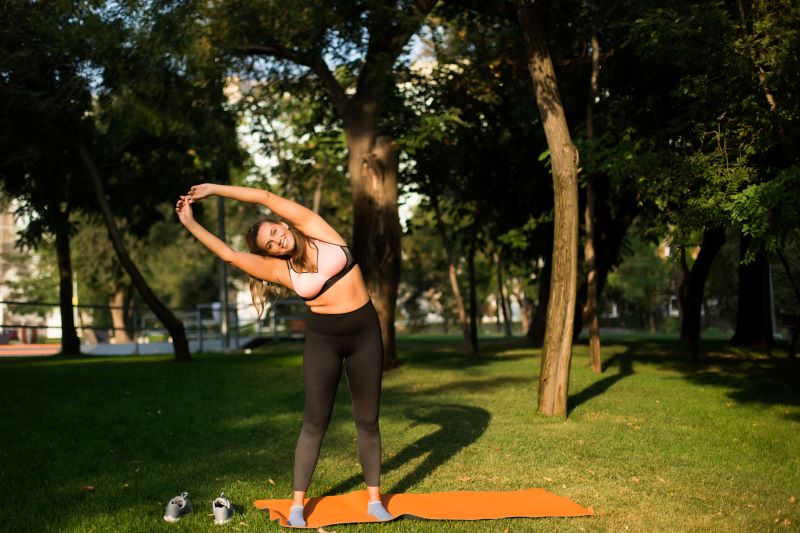
Muscles Involved: Intercostal muscles.
This is a basic exercise. Keep your feet together and lift your arms overhead. Now, clasp your fingers and bend your upper body to either side. Continue breathing normally and stay in the same position for 5-10 seconds. Return to your starting position and do the same on the opposite side.
2. Standing Quad Stretch
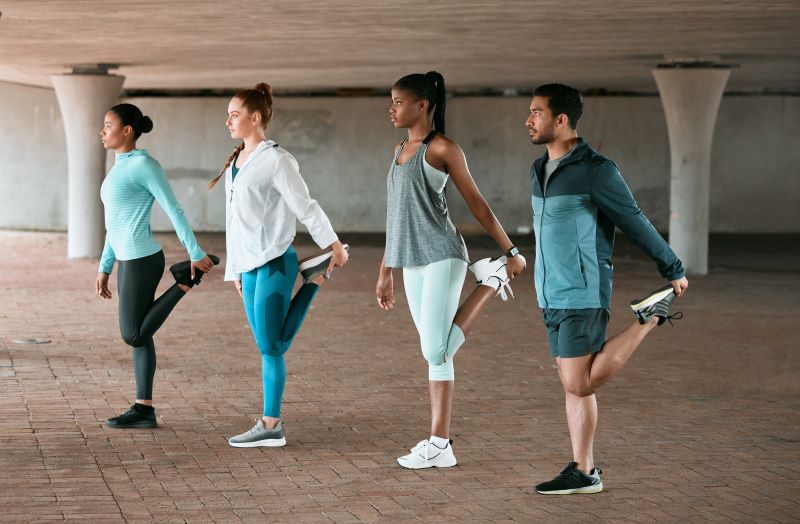
Muscles Involved: Thighs.
One of the easiest exercises to improve flexibility is a standing quad stretch. To do this, stand straight, lift and hold one foot behind you, and pull your foot upwards. When you feel the stretch, hold it for 5-10 seconds. Repeat the same with your other foot.
3. Standing Hamstring Stretch
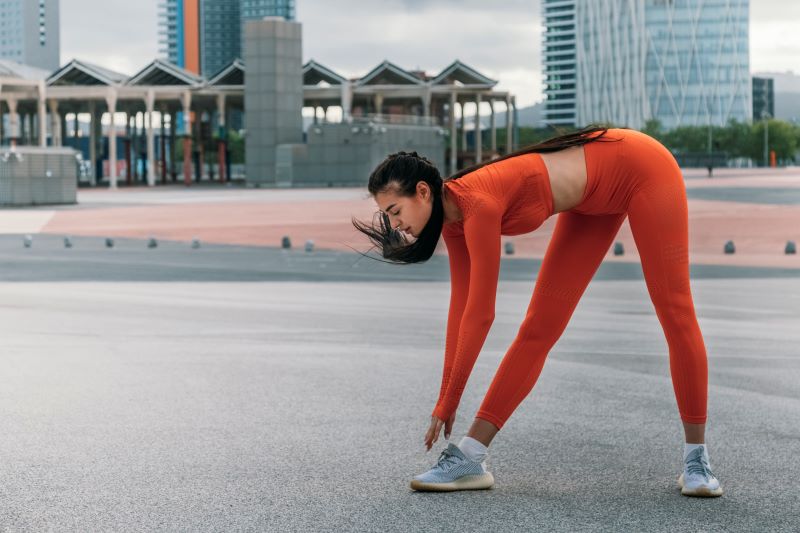
Muscles Involved: Hamstrings, neck, back, glutes, and calves.
Another easy stretching exercise is to stand straight with your hands by your side and your knees slightly bent. Lean forward while keeping your head, neck, and shoulders relaxed. Slowly wrap your arms around your legs and stay in this position for a minimum of 40-45 seconds.
4. Seated Hamstring Stretch
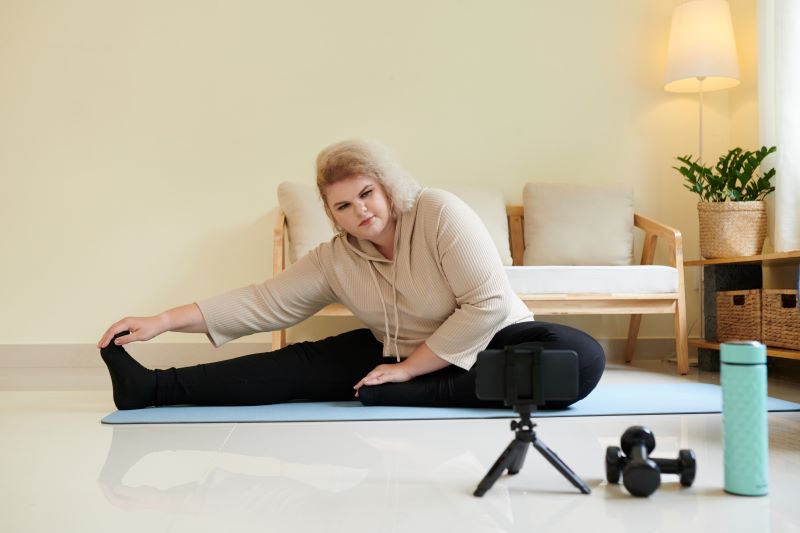
Muscles Involved: hamstring, feet, and shoulder.
This exercise for flexibility and strength relaxes all your leg muscles. To do this, you must sit upright, extend one leg and fold the other, and ensure your feet touch your inner thighs. Then, you try to reach your ankle and pull your toe towards your body. Hold this position for a while, and then repeat this same with your other leg.
5. Standing Calf Stretch
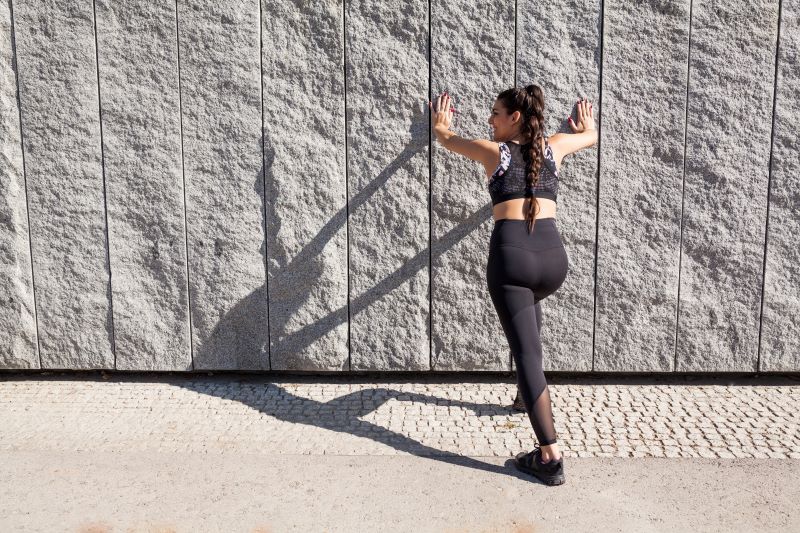
Muscles Involved: Calves.
To stretch at home, stand at least three feet away from a wall with your hands on it. Keep your right foot behind with heels touching the ground, then lean forward. Stay in this posture for a few seconds, then relax and repeat this set with another foot.
6. Shoulders Stretch
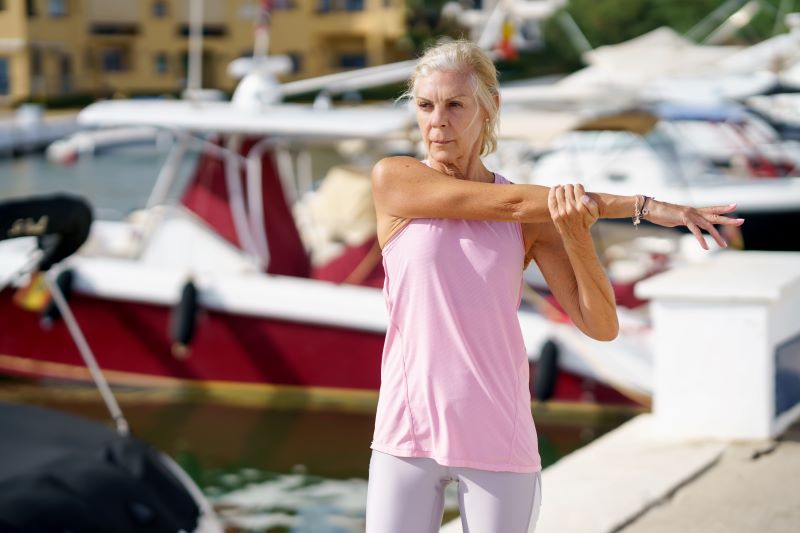
Muscles Involved: Shoulders.
To perform it, stand or sit with your back straight. Extend one arm across your chest and use the opposite hand to pull the extended arm towards your body gently. Hold the stretch for 15-30 seconds, feeling the stretch in your shoulder and upper arm. Repeat on the other side.
7. Forward Hang
Muscles Involved: Neck, back, hips, and glutes.
Stand straight with your feet slightly apart, bend your knees, and lock your fingers behind your back. Extend your arms while inhaling. On exhaling, bend at your waist and extend your hands toward your head. Keep stretching for at least 5 seconds, then return to your starting position.
8. Split Squat
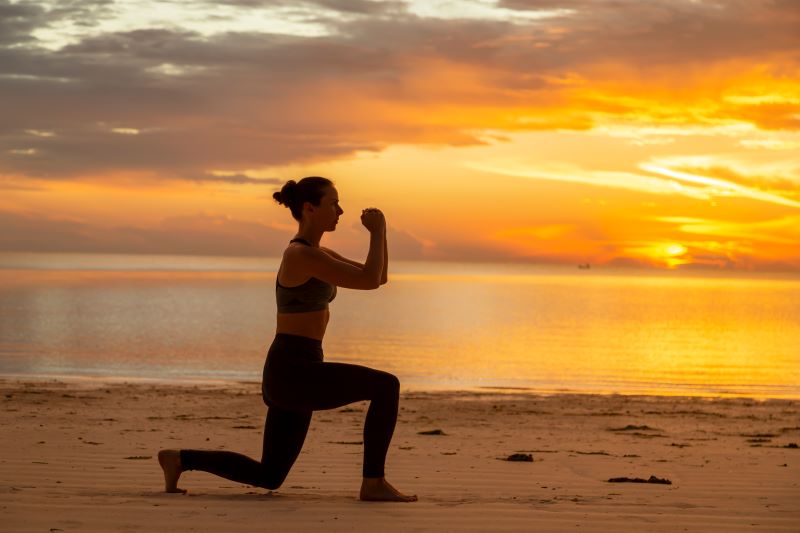
Muscles Involved: Glutes, pelvic, calves and hips.
Keep your right foot in front and hands intertwined under your ribs from standing upright. Take a long step as if you were making lunges. While keeping the upper body straight, lower down until it touches the floor. Push yourself back up and keep doing it by switching the legs.
9. Back Stretch
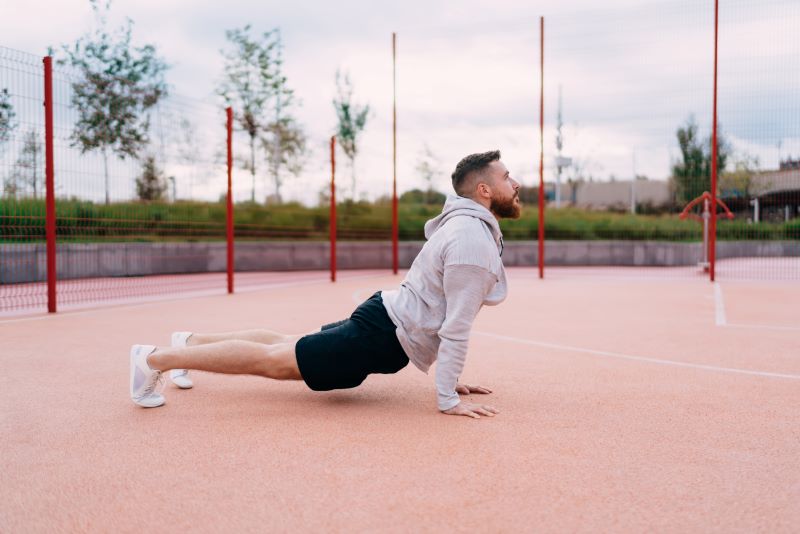
Muscles Involved: Back, shoulders and stomach.
To perform the back stretch exercise, lie down on your stomach and keep your feet slightly at a distance. Inhale and lean backwards, creating a curve. After staying in this position for a few seconds, return to the starting position. Repeat this exercise to strengthen your back.
10. Butterfly Groyne Stretch
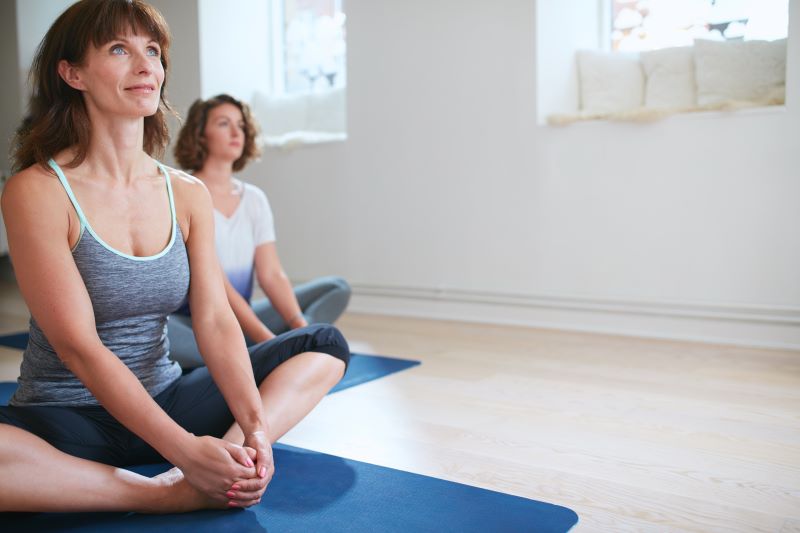
Muscles Involved: Groyne, inner thighs and pelvis.
Sit straight on the ground and bend your knees to touch your feet together. Now try pulling your feet towards your groyne, then put them down with gentle pressure on your knees. You will experience the stretch on the inner thigh and groyne area. Repeat this once to loosen up muscles in that region.
11. Pigeon Pose
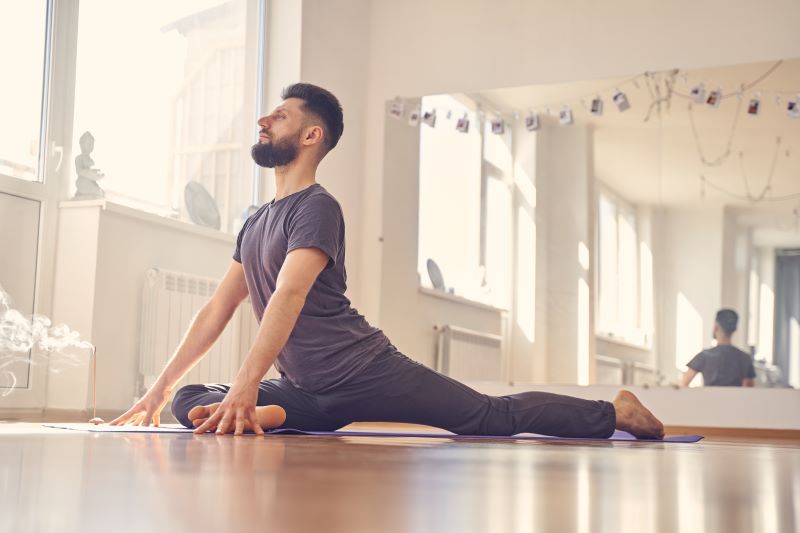
Muscles Involved: Back, groyne, thighs, and hips.
Start in a plank position. Then, bring one knee forward, placing it behind your wrist while extending the other leg straight back. Lower your hips towards the floor and hold the position, feeling a deep stretch in the hip area. This pose helps to release tension and increase hip flexibility.
12. Uttanasana
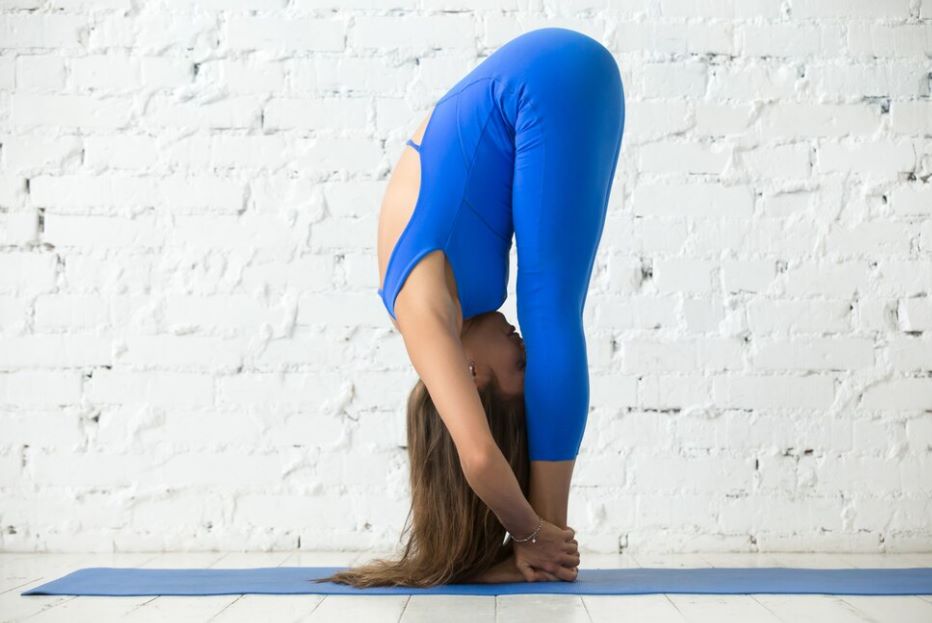
Muscles Involved: Lower back, abdominal muscles, calves, hamstrings, and glutes.
Uttanasana is a yoga pose. Stand with feet together, inhale, and bend forward from the hips as you exhale, bringing your hands to the floor or your shins. Keep your knees slightly bent if needed. Hold the position, feeling the stretch along the back of your legs and spine. This pose calms the mind and relieves tension in the back and neck.
13. Dwikonasana
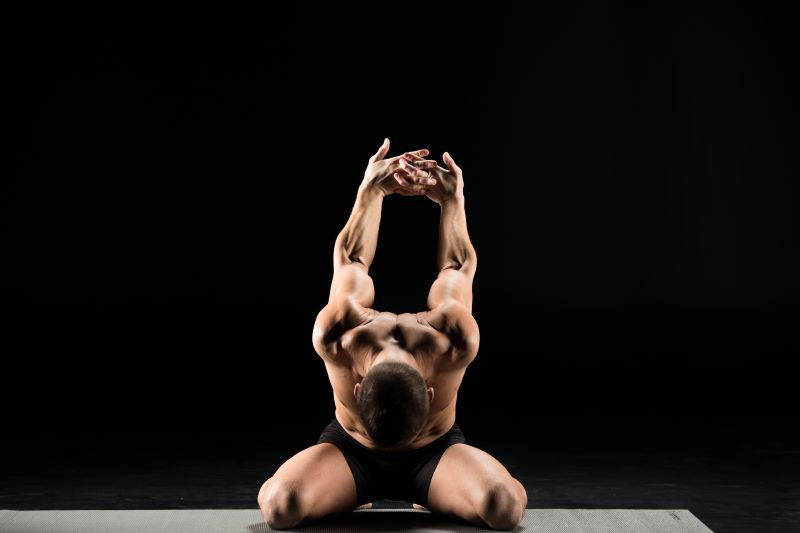
Muscles Involved: Back, shoulders, arms, and hips.
Stand with feet hip-width apart, clasp your hands behind your back, and bend forward from the hips, lifting your arms overhead. Hold the pose, allowing the chest to open and the shoulders to stretch. This pose improves posture and flexibility in the upper body.
For Intermediate and Experts
14. Piriformis Stretch
Muscles Involved: Back and pelvis.
These stretching exercises for flexibility are a little more complicated than the previous ones. Sit on the ground with both legs extended. Cross your right leg over the left. Place your right foot flat and the same hand on the floor behind your body. Rest your left elbow on your right knee. Twist to your right and press your right leg to the left.
15. Lunge With Spinal Twist
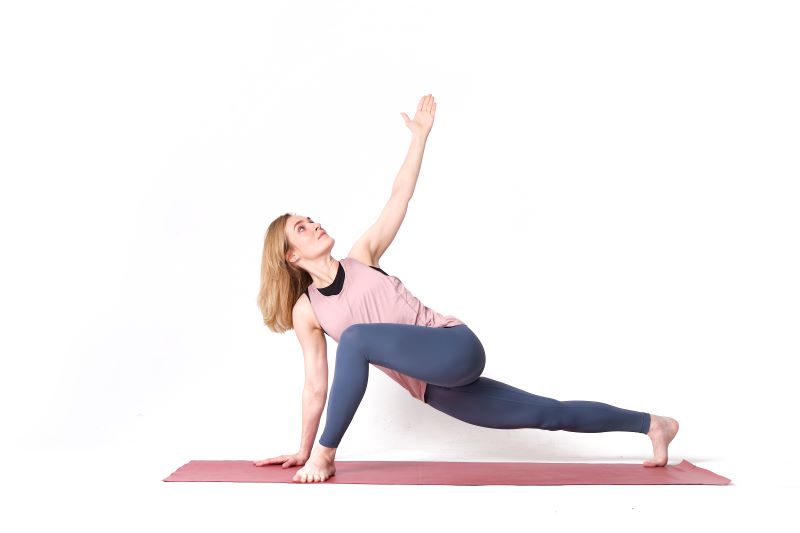
Muscles Involved: Back, quad and flexors.
Stand straight and then step forward, forming a staggered stance. Then bend your left knee and drop it like in lunges. The leg behind your back must be kept straight, and your toes must touch the ground. Then, place your right hand on the floor and twist your torso to the left while extending your left arm upwards. After holding this pose for 30 seconds, repeat on the other side.
16. Figure Four Stretch
Muscles Involved: Hips, glutes, lower back, hamstrings.
Lie on your left side and rest your head on your arm. Fold your right knee and move your hip towards your chest without lifting it. Now, bend your left knee and hold your left foot. If you cannot reach your hands, use a strap. Keep your leg and upper body in line when you touch the ground with your shoulder blade.
17. Triceps Stretch
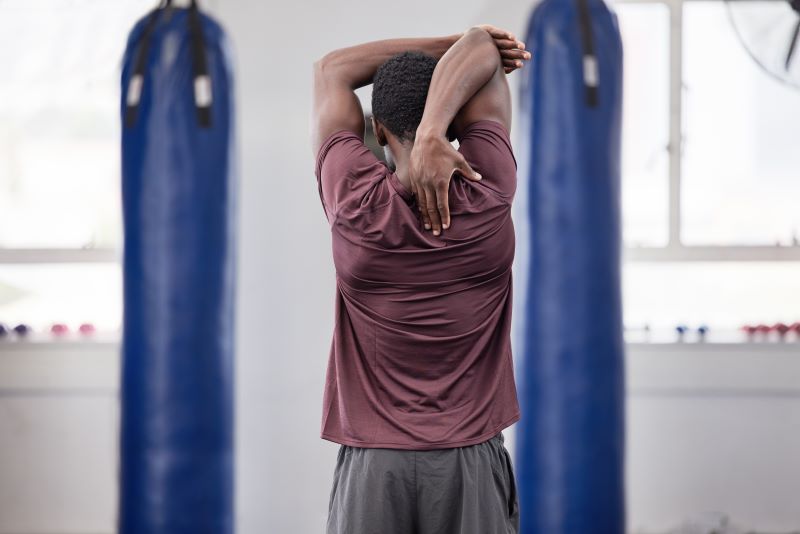
Muscles Involved: Neck, shoulders, back and triceps.
This is the most common upper-body flexibility exercise. You can kneel, stand, or sit with feet and hips-width apart and arms overhead. Bend your right elbow and touch the top middle of your back. Then, reach your right elbow with your left hand and gently pull it towards your head. Hold and keep breathing, then change sides.
18. 90/90 Stretch
Muscles Involved: Hips.
Bend your knees at 90 degrees, calf perpendicular to your body while the sole facing to your left. Bend and place your left knee on the left side, and your foot faces behind you so your muscles are tightened. Keep your right hip on the floor, and move the other side as close as possible. Attempt to hold this position for 30 seconds, and then repeat the same on the other side.
19. Frog Stretch
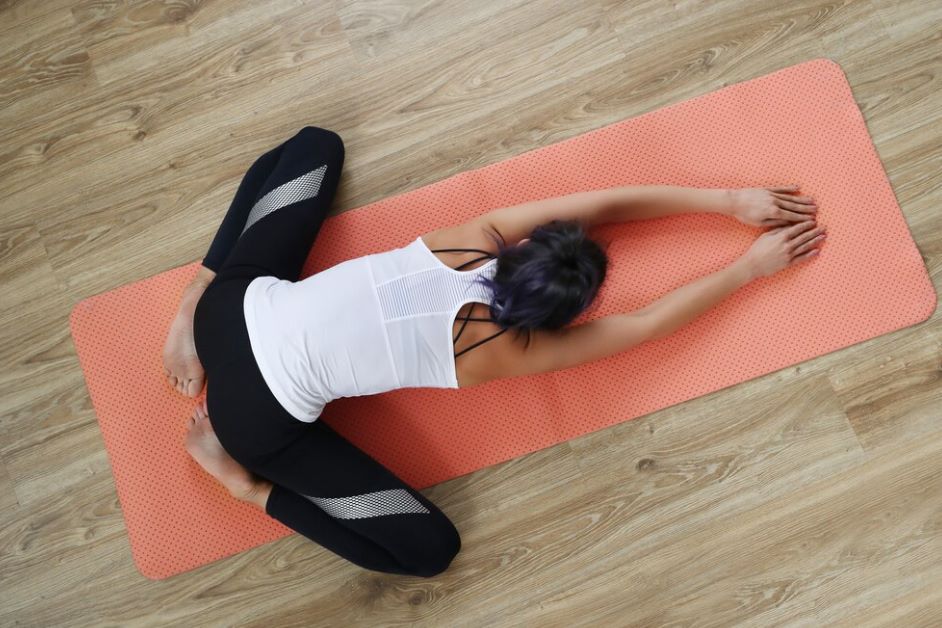
Muscles Involved: Hips and inner thighs.
Get down on both hands and knees, then spread your knees wider than the shoulder gap. The next step is to turn your toes and other inner edges of your feet flat on the floor. Try shifting the hips towards your heels. After mastering this position, try with your forearms for a deeper stretch. Keep stretching in this position for at least 30 seconds.
20. Seated Shoulder Squeeze
Muscles Involved: Upper back, chest and shoulders.
Sit on the floor with your feet flat on the ground and hold your hands behind your back. Then, straighten and extend your arms so that they press the shoulder blades together. Hold this stretch for 3 seconds, then perform it 5 to 10 times.
21. Side Bend Stretch
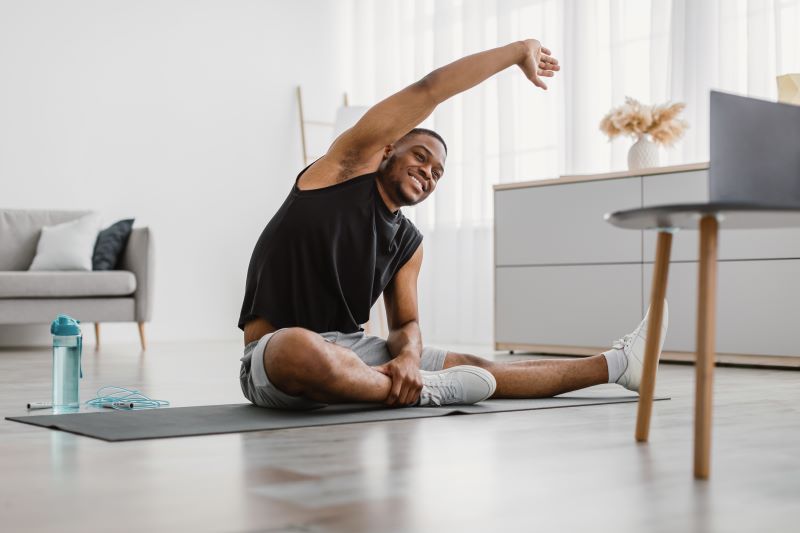
Muscles Involved: Inner thighs, groyne, hips, and obliques.
Keep your back straight, kneel and core tight, and extend your left leg to one side. Make sure your legs are perpendicularly bent at the back. Lift your right arm overhead and rest the left arm on the left leg. Now, slowly bend your torso to the left side. Stay in this position for 30 seconds, then repeat the same on the other.
22. Lunging Hip Flexor Stretch
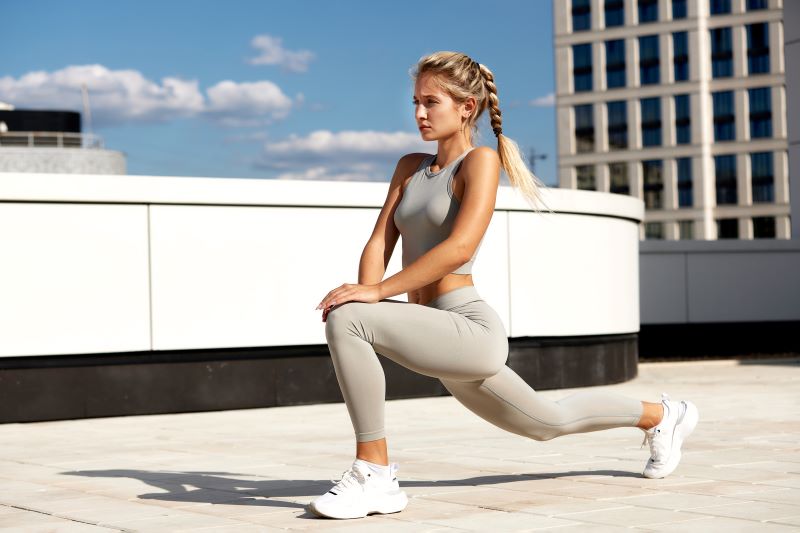
Muscles Involved: Hips, glutes and thighs.
Kneel on your left and place your right foot on the floor just before the knee is bent. Stretch forward so that it can impact your hips. Contract your hips to stretch more. Hold this pose for 30 seconds, then switch and repeat the same flexibility exercise.
23. Lying Pectoral Stretch
Muscles Involved: Chest and shoulders.
Make a ‘T’ shape with your body, lie down on the floor and extend your arms on the side of your head. Push off the ground with one hand, bend the same knee to get some balance, and then roll in the opposite direction. With more practice, your body will increase mobility and help you stretch more.
24. Knee to Chest Stretch
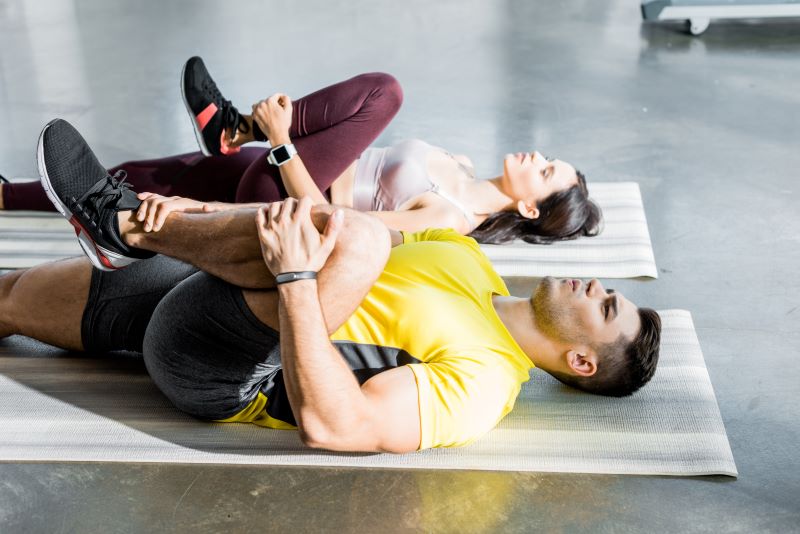
Muscles Involved: Hamstrings, lower back and hips.
Another easy but highly impactful flexibility exercise is this stretching. Lie on your back and pull your left knee into your chest. Remember to keep the other leg straight and the lower back fixed to the ground. Hold one leg for at least 30 seconds, then put it on rest and repeat the same with the other leg. Once both legs are done separately, bend them and repeat the same position.
25. Lying Quad Stretch
Muscles Involved: Quads.
This is similar to the quad stretch. The only difference is that you must do the same by lying on the ground. Lay down on one side and keep the bottom leg straight. Bend the other one so that it touches your hips. Try not to move while you are in this position. After holding the pose, change sides and repeat this stretching.
26. Sphinx Pose
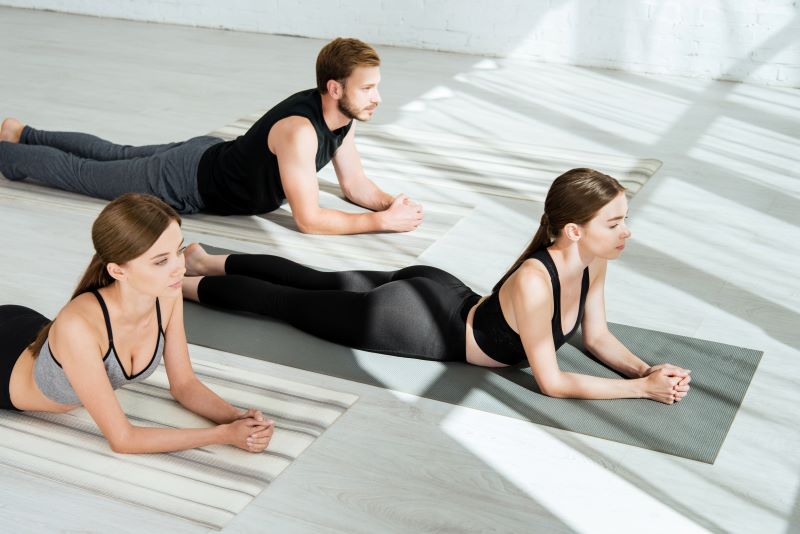
Muscles Involved: Chest, shoulders, and lower back.
One of the best flexibility exercises is doing the sphinx pose. Lie down on your stomach and align your shoulders with your elbows. Now, with the support of your forearms, lift your upper body. Make sure your belly remains touched down. Try contracting your hips and thighs as you lengthen your spine and keep your shoulders relaxed.
27. Extended Puppy Pose
Muscles Involved: Glutes, back and shoulders.
Again, get down on your hands and knees and slowly move your arms forward while curling up your toes. Push your hips up but halfway back towards the heels. Maintain straight arms by keeping them pushed against the floor. When you feel a stretch, hold on to that position for a while, then return to the relaxed position and repeat.
28. Pretzel Stretch
Muscles Involved: Glutes, quads, hips, back and obliques.
Lie on your left side and rest your head on your arm. Fold your right knee and move your hip towards your chest without lifting it. Now, bend your left knee and hold your left foot. If you cannot reach your hands, use a strap. Keep your leg in that position, and ensure your upper body remains in line when touching the ground with your shoulder blade.
29. Reclining Bound Angle Pose
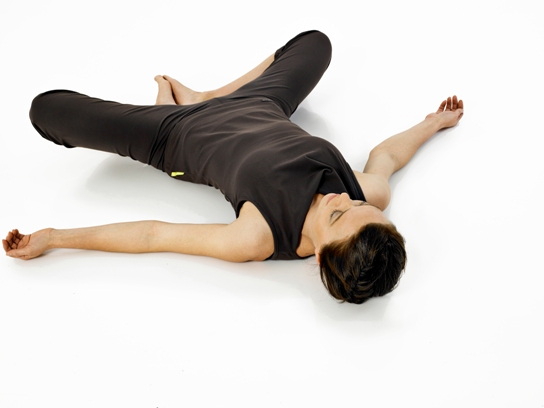
Muscles Involved: Inner thighs, groyne and hips.
In this exercise, you need to lie on your back. Gently put your soles together and let the knees open up. Try to move it closer to the floor to get more stretched out. Stay in this position for as long as possible at your convenience, then slowly move back to the starting position.
30. Lizard Pose
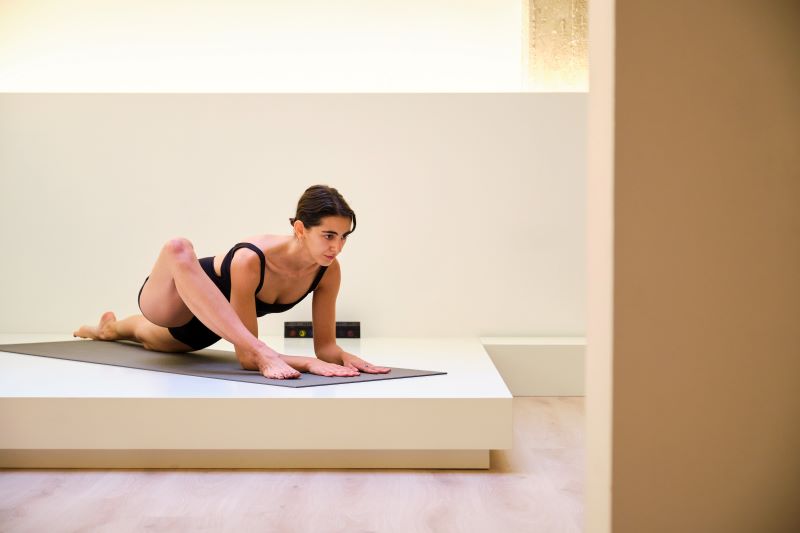
Muscles Involved: Quadriceps, hamstrings, and hip flexors.
Lizard pose is a deep hip opener exercise. Begin in a low lunge with your hands inside the front foot. Lower your forearms to the ground or keep your hands on the mat, extending the back leg straight. Hold the pose, feeling the stretch in the hip and thigh muscles. This pose enhances hip flexibility and mobility.
Types of Equipment Required for Flexibility Exercise
The table mentioned below lists the equipment that you will need for performing the flexibility mentioned above exercises:
Exercise |
Equipment Required |
| Standing Quad Stretch | Wall or Chair |
| Seated Hamstring Stretch | Yoga Strap (if required) |
| Standing Calf Stretch | Wall or Elevated Surface |
| Lying Quad Stretch | Yoga Strap (if necessary) |
How Does Exercise Help in Improving Flexibility?
Physical activities' primary benefit is that they prevent injuries, backaches, and issues with body balance. Regular stretching and other exercises also improve and regulate blood flow.
Here are the benefits of combining correct stretching methods with other workouts:
Enhances your performance in every kind of physical activity.
Reduces risks of getting injured.
Improves joint movement.
Boosts blood flow to all organs and joints.
Impacts on muscular movements.
Improves daily functional activities.
Who Should Avoid Flexibility Exercises?
Doing flexibility exercises daily can improve several health aspects. However, specific scenarios exist when one must refrain from doing these exercises.
The list below highlights some instances when you should avoid stretching exercises:
People with a knee or any joint injury.
Someone with acute muscle or ligament strain.
Those with a nerve injury.
An individual who had surgery and is still recovering.
A person when suffering from a muscle spasm.
Safety Precautions to Take While Doing Flexibility Exercises
Although doing flexibility exercises at home looks very harmless, some require proper guidance. Therefore, those can get a trainer or a healthcare supervisor while stretching or exercising. Others can carefully understand the correct technique before beginning.
Following are certain safety measures you can take while doing these exercises:
Start with a brief but effective warm-up session to avoid muscle stiffness.
Do stretching exercises until you reach a point of tightness, but never force yourself beyond your comfort level.
Stretch slowly; do not hurry while stretching.
Remember never to bounce or create any jerk when stretching.
Concentrate on breathing naturally. Never hold your breath.
Some of these flexibility exercises can be done while warming up, while others can be done when cooling down. However, it remains a mandate that these must be done by combining with other forms of exercise. This is because stretching alone cannot effectively promote flexibility in your body.













